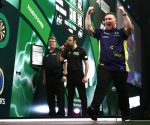The Shot of His Life
There are shots worth millions of dollars, shots that build legacies and shots that spark careers. But away from the tours, far from the big money and the cameras, there are shots that carry a different kind of pressure. Those are the shots that nobody will ever know about, but that define entire lives. And some of those shots are miracles.
Teven Vargo has a weird name, and he knows it. If you call the pro shop at Hillandale Golf Course in Durham, N.C., where he works as an assistant professional, he's the only one who won't say his name when he picks up the phone. It's not because he isn't personable—he just got sick of people calling him Kevin.
"Vargo" is Hungarian, and "Teven" happened because his dad liked the R&B singer Tevin Campbell. As for that slight Tevin-Teven difference, his parents are named Kris and Tami, and the family tradition of slight name variations is so ingrained that even with a name that was already offbeat, they couldn’t resist a tweak. When you ask their son, though, he'll offer a different explanation…with a face so straight you have to know him to understand it's tongue-in-cheek:
"My parents hate me and wanted everyone to think I misspelled Steven."
Up to this point, Vargo’s life story has been sufficiently weird to match his name. We'll get to the specifics momentarily, but for now, the salient fact is that his journey in golf brought him to Keith Hills Golf Course in Lillington, N.C., this past summer for his fifth attempt to pass the Player Ability Test (PAT) and become a PGA of America professional. All four of his previous attempts were failures, and they all came at the same course. At this point he hated Keith Hills, more than he'd hated any track in his life, and yes, he could have gone elsewhere, but in his heart he had a vendetta, and he needed to conquer the beast in its own lair.
And then, he vowed, he’d never come back.
The PAT looms as a massive roadblock for any aspiring PGA professional. To go from assistant pro—which often entails long hours with low pay and is rife with burnout—to a full, certified PGA of America professional, this is the demon at the gates. According to Jesse Dodson at the PGA of America, there were 7,800 attempts in 2024, with a success rate of 30 percent, while the numbers so far in 2025 are 8,000 and 29 percent. The standard method of passing is simple—you play 36 holes in a day, and your total score must be the course rating plus a 15-stroke cushion. At Keith Hills, where the course rating rounds to a 71, that meant Vargo's target score for 36 holes was 157.
The first time he tried, in 2022, Vargo posted an 84-83, which felt fine considering he hadn't played competitive golf in nine years. He got better the second time, with an 82-81, but now he was pissed. His best career round was 69, and he consistently shot in the low 70s at Hillandale. What was going wrong at the test, and how could he fix it?
More From Golf Digest 


He spent all of 2023 working on his swing. He calculates that he hit 300 to 500 balls every day and rarely played on the course. His body was worn out, but his obsession fueled him. He went so deep into swing mechanics that he didn't even take the test that year.
When he tried again in 2024, he took his best friend Cody Stinson to caddie and felt that his game was as good as it had ever been. Optimism abounded, but disaster abided: 84-92. On the long ride home, Vargo kept thinking about how he hadn’t shot a competitive round in the 90s since his freshman year in high school.
The rest of that year, he changed his MO completely. He eschewed practice for play, read some books on psychology, and went to work with a sports therapist. I don't know what's going on with my brain, he told him. Slowly but surely, he regained confidence. This past April, back at Keith Hills for his fourth try, he shot 82-82. Better, but still eight shots off.
He needed to pass the test badly—even more than your average assistant pro. He was 30 years old now, and his timeline was shrinking. Every test he failed was hundreds of dollars he didn't have to spend, blown confidence that he didn't have to lose and a future he had risked everything for that looked less and less assured. He began to wonder if he should even stay in the industry; if he couldn't pass, how could he achieve the goal that he and his best friend had been nursing for a decade?
It had to happen this year.
Vargo working on his swing at the Hillendale driving range in hopes of passing the PGA Playing Ability Test. (Photo courtesy of Teven Vargo)
What he didn't know was that two months later, he'd get to the brink. He'd play up to his potential and stand on the final hole of the day with a chance to put it all behind him. Then he’d hit his tee shot, walk to his cart, put his head in his hands, and think to himself:
You lost it.
You fucking blew it.
Long before he took the game seriously, Vargo worked on a golf course. Harbor Ridge is a nine-hole track just east of Erie, Pa., right off the great lake of the same name and two hours from everywhere—Buffalo, Cleveland, Pittsburgh. His mom played there in a weekly women's league. And if one of what he called "the grandmas" didn't show up, they'd sub him in to make up the numbers.
"I grew up playing in the old woman's league," he said, "and I just fell in love with the game."
He got serious in high school, started shooting in the 80s and played four years of varsity golf. He started to posting scores in the 70s as a senior, and he went on a tear to end his career, qualifying in succession for districts, regionals and states. As he progressed, he had the feeling he was in a little above his head, and he had that confirmed when he was paired with a high-level Division I recruit who started seven under through his first eight holes.
"I wasn't playing bad," he said. "I was like three or four over, and he was annihilating me."
Vargo (middle) from his high school golf days in Pennsylvania, with Stinson (left). (Photo courtesy of Teven Vargo)
That was the only time he experienced high-level golf in person. He wasn't good enough to play in college without a serious commitment, and as a self-described "stupid" 18-year-old, he lacked the requisite drive. He went to Allegheny College in nearby Meadville, "partied his ass off" and moved to Ohio after graduation to work in corporate sales and play golf on weekends.
Enter Cody Stinson. You can't separate the story of Vargo from the story of Stinson, just like you can’t separate the two of them in real life. They've been best friends since middle school, and because Vargo went to college with Stinson's girlfriend-now-wife Natasha, they stayed close when he visited. It was Teven who introduced Cody to golf in the first place, and now Cody was trying to bring him back into the fold.
Stinson made his first play in 2019. He had worked in sales, too, but he left for the golf world, and he called his friend from Hillandale Golf Course in North Carolina, where he had landed a job as assistant pro that September. Come down, Stinson told Vargo, it's a good situation here. But the response was a resounding "hell no." Why would he leave a cushy corporate job to go into the golf industry and make no money?
A few months later, Stinson tried again. This was a course they could eventually run, he said. This wasn't just a stepping stone on the path to becoming a head professional—they could own Hillandale together one day and run the business together. As kids, they had joked about buying a golf course, and when they both worked in sales, they had fantasize about it on phone calls. Now they had a real chance. This time, Vargo came down for a visit. He liked what he saw, but it didn't change his answer. It would take something dramatic to make that happen… something like a global pandemic.
When COVID hit, Vargo’s traveling job turned into monotonous desk work and he began submitting applications to business schools. One afternoon, after a particularly bad day, Vargo got another call from Stinson. An assistant had just been fired at Hillandale. Why wouldn't Vargo at least interview?
He interviewed. He got the job. They flew him down to see the course. The temptation grew. But he wouldn’t leave if there wasn’t a real chance to run the place one day.
"Is this a reality?" he asked Stinson.
"I think we could do it."
Vargo’s sister, who lived in nearby Raleigh, loaned him her two-door Honda Civic. He drove back to Ohio, quit his job, turned in his company phone and car, and uprooted his entire life for a dream.
Stinson started working at Hillandale in 2019, eventually convinced Vargo (right) to come join him in 2021. (Photo courtesy of Teven Vargo)
Hillandale Golf Course has been a staple of Durham since the early 1900s, but in 2010, hampered by mismanagement, it was hemorrhaging money and on the verge of being turned into a park. Karl Kimball was the man who rescued it, striking a unique Hail Mary deal with the city in which it would own the land, but he would operate the course at full financial risk to himself. The gamble worked, and today the course is thriving. When Vargo first visited, he had an inside track with Kimball thanks to the groundwork laid by his best friend.
“Cody has been such a bright light in our industry,” Kimball said, “and I’m one of those guys where, if you’ve got somebody like that, and he has a friend, that friend ain’t gonna be too far from the same thing.”
Vargo started in May 2021, and there were several times in the first six months when he asked himself what the hell he had gotten into, going from a comfortable corporate salary to scrub assistant money. But he started getting into the rhythm of the job and learning how to play golf again, and beneath it all he and Stinson had the dream they'd been dreaming since they were kids. In the meantime, Vargo was impressing Kimball with his focus and his intelligence, particularly his facility with numbers and money. Before long, the dream became tangible—Stinson and Vargo were the heirs apparent.
The problem was, Vargo still had to pass the PAT test. You can't just own a golf course without the right credentials, unless you're incredibly wealthy, which Vargo wasn't. They had to establish their bona fides. Kimball told him flat out: For me to consider this, you have to be a PGA member. It was easier for Stinson—he passed his PAT on the number a year after landing the job, holing a short putt on the 18th green at Keith Hills while students from Campbell University, looking on, heckled him: "You're going to miss!"
Now it was Vargo's turn. But two misses in 2022, the ill-fated swing obsession the next year, and two more misses in 2024 and early 2025, and the doubts he had harbored from the start had become shadows that followed him at every step. His fourth failure at Keith Hills provoked something like an existential crisis in his game.
Vargo (left) and Stinson visited PGA of America headquarters in Frisco, Texas, as they work toward their dream of being PGA of America members and running their own golf course. (Photo courtesy of Teven Vargo)
“When I first started working with Teven,” Kimball remembered, “he’d hit a tee shot, and you’d need a scout troop and a compass to find the golf ball. He could hit it far—far into the woods. But he learned the golf swing, he learned the mechanics, and he learned how to teach it. The hard part is, now you gotta do it yourself.”
Spring gave way to summer, and Hillandale got busy. Vargo barely had time to practice at all, much less play, as he helped manage a public course that, like many others, has been setting records for rounds played year after year since the pandemic hit. He signed up to take the PAT for the fifth time in June and instantly regretted it—he was mentally crushed and unprepared, and at the hotel the night before, he felt the nerves grow until they had transformed into waves of panic.
"I felt like shit the whole night," he said.
Without a better plan and staring down the barrel of what was shaping up to be another failure, he walked across the street for a drink. He was by himself this time—he didn’t want to subject Stinson to another day of fruitless caddie work—and sitting over his beer, the loneliness hit hard.
In the morning, he felt worse. But as he got ready, the negativity became so overwhelming that it prompted a new emotion: defiance.
"I was just like, you know what? It's just another fucking day,” he said. “I'm just going to go out and say fuck it. I'm going to give it everything I have."
It worked. Sort of. He made six pars on the front nine for a 39, right on pace, and after going five over in his first four holes on the back, he settled down to finish with four pars and a birdie. Final score: 79. For the first time at Keith Hills, he'd broken 80. Now he needed to do it again, because with a target score of 157, only a 78 or better would see him pass.
Vargo's scorecard from the morning round at Keith Hills in June. (Photo courtesy of Teven Vargo)
At the PAT, players are paired randomly together and keep each other's scores, and on that day around 45 aspiring professionals were trying to pass. Vargo's two partners had already blown their chance, and at this point were mostly along for the ride. They took carts at Keith Hills, and the high stakes lead to a glacial pace, with rounds spilling over the five-hour mark. On this particular day, Vargo's partners were not breaking 90, which slowed the pace even more. Adding to that cauldron, the heat index was typical for North Carolina in June—103 degrees and humid. By the end of that day, only a small handful of the 45 at Keith Hills managed to pass, far lower than 30-percent average.
Despite the heat and fatigue, Vargo's animating thought as he began his second 18 was that he didn't want to do it ever again. It didn't necessarily help his mindset, but on the front he managed to limit the damage and shoot a 40, which meant he needed a 38 on the back. The way Vargo thought of it, he had two bogeys to spare.
On the 10th hole, a demanding par 4 with a sharp dogleg, he blew his tee shot into the trees and made a double bogey.
His cushion was gone. Now he had to play the rest of the round at even par, and on 11, as if the universe wanted to put him out of his misery quickly, his tee ball went in the water. He dropped, had 180 yards left to the pin and knew it was time to go for broke. He hit a 6-iron, and the minute he made contact, he thought it was perfect. It landed three feet from the hole, and in his first miracle of the day, he made par.
On 12, he hit an overhanging tree and left himself 250 yards to the green. Lucky for Vargo, for the weaknesses that exist in his game, his strength is distance, and he hit a slinging cut onto the green with a 2-iron and saved par. On 13, with bad memories of hitting a driver OB and taking double, he hit 2-iron again and blew it right.
He couldn’t get off the tee. He was so nervous, he didn’t feel like he could do anything. But he could scramble. Under the trees, he managed a sweeping slice that found the fairway, and gave himself a birdie putt that lipped out. Par. If he could make five more pars, he'd pass the test.
They had stretched the par-3 14th to 201 yards that day, and his 5-iron found the same sand he had hit with the 6-iron in the morning. He wedged out to 18 feet and, sensing that any miss would spell the end, he sent it at the cup with pace and watched it hit the back of the hole. Another small miracle.
Four straight ridiculous pars, but four more needed. On 15, he went back to his 2-iron off the tee, told himself not to push it right again and pulled it left into the trees. It left him 250 yards again. On a par 4.
Jesus.
In the thick rough, desperate to stay alive, he launched a wood that stopped 15 yards from the hole. His chip was too aggressive and left him 15 feet downhill for the par. Seeking a fifth straight absurd save, his magic ran out. When he tapped in for bogey, he was officially off the pace.
There was one saving grace, and it was 18—a par 5 he had birdied in the morning. He would need to do it again for his 78, but first he had to survive 16 and 17. Finally, on 16, he hit a fairway and green in regulation, and his birdie attempt lipped out and hung on the edge. Par. On 17, a par 3, to the astonishment of his playing partners, he lipped out a second straight birdie putt.
It all came down to the 36th hole. He had to be aggressive now, because par wasn't good enough, but he was still too scared of the driver. He opted instead for the 2-iron that had let him down almost the entire back nine. Standing on the tee, he told himself to be aggressive with the swing … and pushed the ball right, into more trees.
He made the slow walk to the cart. He sagged. He put his head in his hands. You fucking blew it. He settled into a state of quiet devastation. Everyone around him, too, knew he had just blown it.
They found his ball on the cart path. The only consolation was that the hole was playing up compared to the others on the course, so his distance wasn't as terrible as it could have been: 276 yards. He took a drop on the pine straw, stared at a window about 10 yards wide between the trees, thought about the bunkers protecting the green up ahead and about the root close behind his ball.
He pulled 3-wood from the bag. What else could he do? There was no other option—he had to hit the shot of his life. He took a breath and swung as hard as he could.
"As soon as it came off, I was just like, 'holy shit,'" he said. "I see the ball go off between the trees. It has to cut about five yards, and it's doing it, it's cutting five yards right at the pin."
The freak-out began. He ran to the cart, but he had to wait for the other guys to hit. He screamed at them in silence: Hurry! When he finally rounded the bend and drove to the green, he saw it: His ball, center of the green, below the hole, with 13 feet for eagle.
He took about five minutes to read the putt. He stared it down from every side. Two putts to pass the PAT, to take the next step in a dream. His eagle putt was aggressive, but not too aggressive, and the ball came to rest six inches from the hole. When he tapped in for birdie, he fell to his knees.
What followed was the unsexy work of finishing the process. Vargo and Stinson did everything together except the PAT, and once that was over, they finished their coursework in Texas. They are now in the process of submitting a variety of assignments on the topics you would expect—how to run a golf business, how to teach, how to coach. Then they’ll take the cumulative exam, stand for election to the PGA and be approved by the board. If everything goes as planned, by December or January, they’ll be official PGA professionals. Kimball will have a party for them at Hillandale, and it will be another milestone on the path to a dream. And while that will come with a deep satisfaction—the reward for endurance—it will be different from the ecstatic wavelength the two shared on that afternoon at Keith Hills, when Vargo texted a picture of his card to Stinson. The response was succinct:
“Holy shit."
In that image, both of them could see their future.
















